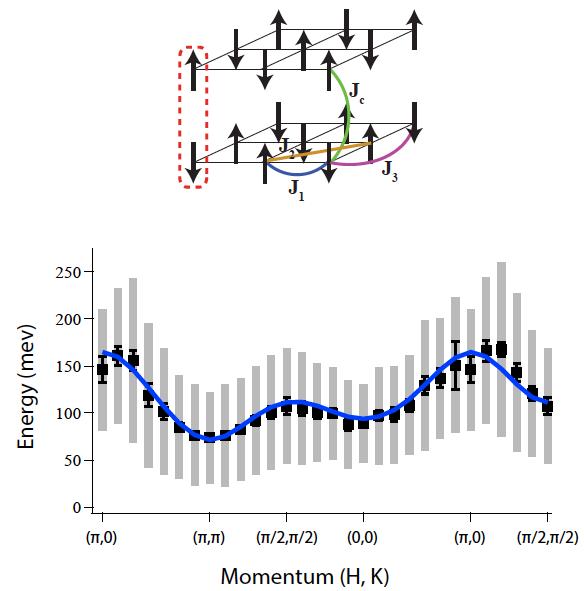X-RAY RUNS: Apply for Beamtime
2017 Nov 1 - Dec 21
2018 Feb 7 - Apr 3
2018 Proposal/BTR deadline: 12/1/17
2018 Apr 11 - Jun 4
2018 Proposal/BTR deadline: 2/1/18
A team led by researchers at the Materials Department University of California, Santa Barbara, working at CHESS C1 station and the Advanced Photon Source, have revealed a hidden, disordered dimer state in the electron-doped bilayer spin-orbit Mott insulator Sr3Ir2O7 [1]. Sr3Ir2O7 is an unusual manifestation of a bilayer square lattice of spins (as illustrated at top of the Figure) due to the extended exchange inherent to its 5d electron valence states and their large orbital extent, not only within but also between bilayer planes. As a result, this system potentially exists in a unique parameter space where the strength of magnetic exchange coupling between these planes can approach or exceed the strength of the coupling within them. For strong enough coupling between planes, a novel dimer state can emerge, and the antiferromagnetically ordered iridate Sr3Ir2O7 was previously proposed to be on the verge of this state [2]. This work explores the magnetic properties of electron-doped Sr3Ir2O7 via resonant x-ray scattering measurements and static spin susceptibility measurements. Upon electron doping, resonant elastic x-ray scattering collected at C1 beamline reveals that static antiferromagnetism vanishes, while resonant inelastic x-ray scattering at the Advanced Photon Source shows that spin dynamics persist nearly unchanged into the disordered regime. At the same time, local moments consistent with doped electrons breaking disordered dimer pairs appear in the static spin susceptibility. Taken together, this suggests the presence of a novel dimer state with appreciable interdimer correlations.
 Figure: (Top panel) Exchange couplings inherent to square-lattice bilayers comprising the spin system of Sr3Ir2O7. Dashed line denotes a potential dimerization of spins, between layers of the bilayer, beyond a critical ratio of inter-plane to in-plane exchange coupling. (Bottom panel) Magnon dispersion persistent in electron-doped Sr3Ir2O7 once doped into the magnetically disordered phase (~ 10% electrons/Ir).
Figure: (Top panel) Exchange couplings inherent to square-lattice bilayers comprising the spin system of Sr3Ir2O7. Dashed line denotes a potential dimerization of spins, between layers of the bilayer, beyond a critical ratio of inter-plane to in-plane exchange coupling. (Bottom panel) Magnon dispersion persistent in electron-doped Sr3Ir2O7 once doped into the magnetically disordered phase (~ 10% electrons/Ir).
A key measurement, performed at CHESS station C1, was to probe a sample doped just beyond the observed collapse of long-range AF order. When no signal was observed at the nominal magnetic wave vector, scans along high symmetry directions of the magnetic zone were also conducted. Given the sensitivity of the instrument and the lack of any observed magnetic signal, static AF order could be precluded above a lower bound of 0.06 μB/Ir. This convincing evidence for the absence of static magnetic order, coupled with evidence of persistent spin dynamics into the disordered regime of the phase diagram suggests realization of a disordered dimer state in Sr3(1-x)La3xIr2O7.
Further details can be found in the full publication Physical Review B: https://doi.org/10.1103/PhysRevB.94.100401
References:
[1] Tom Hogan, Rebecca Dally, Mary Upton, J. P. Clancy, Kenneth Finkelstein, Young-June Kim, M. J. Graf, and Stephen D. Wilson, “Disordered dimer state in electron-doped Sr3Ir2O7” Physical Review B Rapid Communication 94, 100401(R) (2016).
[2] M. Moretti Sala, V. Schnells, S. Boseggia, L. Simonelli, A. Al-Zein, J. G. Vale, L. Paolasini, E. C. Hunter, R. S. Perry, D. Prabhakaran, et al., Physical Review B 92, 024405 (2015).
Submitted by: Ken Finkelstein, CHESS, Cornell University
11/07/2016
